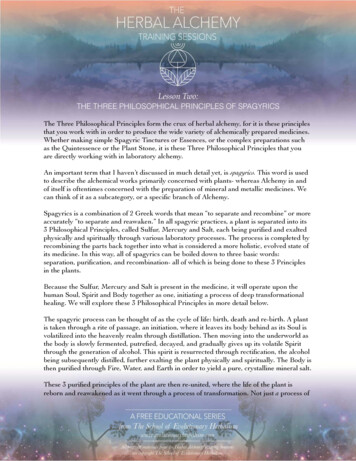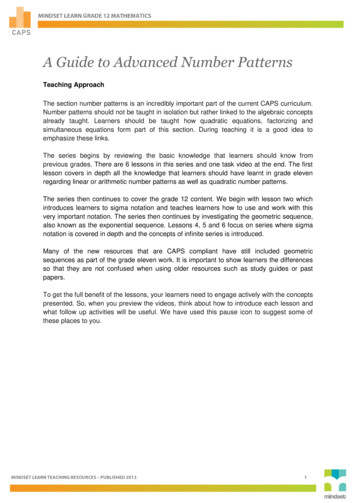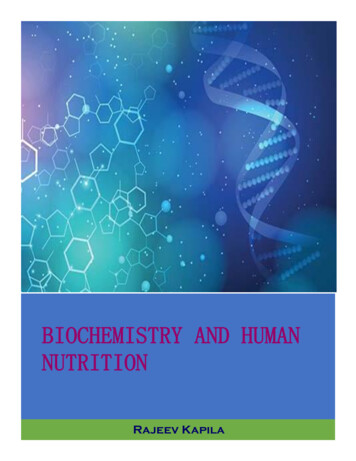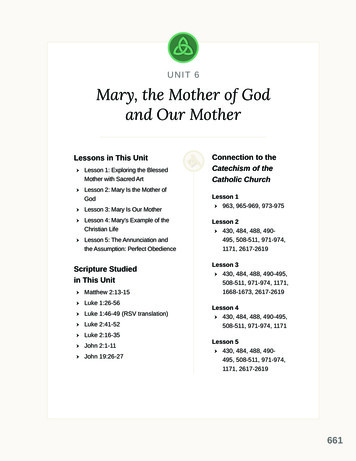
Transcription
Lesson Two:THE THREE PHILOSOPHICAL PRINCIPLES OF SPAGYRICSThe Three Philosophical Principles form the crux of herbal alchemy, for it is these principlesthat you work with in order to produce the wide variety of alchemically prepared medicines.Whether making simple Spagyric Tinctures or Essences, or the complex preparations suchas the Quintessence or the Plant Stone, it is these Three Philosophical Principles that youare directly working with in laboratory alchemy.An important term that I haven’t discussed in much detail yet, is spagyrics. This word is usedto describe the alchemical works primarily concerned with plants- whereas Alchemy in andof itself is oftentimes concerned with the preparation of mineral and metallic medicines. Wecan think of it as a subcategory, or a specific branch of Alchemy.Spagyrics is a combination of 2 Greek words that mean “to separate and recombine” or moreaccurately “to separate and reawaken.” In all spagyric practices, a plant is separated into its3 Philosophical Principles, called Sulfur, Mercury and Salt, each being purified and exaltedphysically and spiritually through various laboratory processes. The process is completed byrecombining the parts back together into what is considered a more holistic, evolved state ofits medicine. In this way, all of spagyrics can be boiled down to three basic words:separation, purification, and recombination- all of which is being done to these 3 Principlesin the plants.Because the Sulfur, Mercury and Salt is present in the medicine, it will operate upon thehuman Soul, Spirit and Body together as one, initiating a process of deep transformationalhealing. We will explore these 3 Philosophical Principles in more detail below.The spagyric process can be thought of as the cycle of life: birth, death and re-birth. A plantis taken through a rite of passage, an initiation, where it leaves its body behind as its Soul isvolatilized into the heavenly realm through distillation. Then moving into the underworld asthe body is slowly fermented, putrefied, decayed, and gradually gives up its volatile Spiritthrough the generation of alcohol. This spirit is resurrected through rectification, the alcoholbeing subsequently distilled, further exalting the plant physically and spiritually. The Body isthen purified through Fire, Water, and Earth in order to yield a pure, crystalline mineral salt.These 3 purified principles of the plant are then re-united, where the life of the plant isreborn and reawakened as it went through a process of transformation. Not just a process of
Lesson Two:THE THREE PHILOSOPHICAL PRINCIPLES OF SPAGYRICStransformation, but the process of transformation that everything in life goes through inorder to further its evolution. The way I see it, this process is actually healing the archetypeof the plant. Traditionally, this process is usually described as bringing that particularspecies to a greater state of perfection.Now a lot of people get triggered here. Isn’t the plant already perfect and pure the waynature makes it? To that I say, “of course!!” All of nature is perfect in and of itself. But whenwe are going to utilize something from nature, we can work with it in ways to make it moresuitable for our use.For example, you can take all of the wool off of a sheep and pile it on top of you to use as ablanket, but that cannot compare to wool that has been washed, carded, spun, dyed, andwoven into a beautiful blanket! Just because we take wool and weave it into a blanketdoesn’t mean that the wool in its raw state is imperfect or bad. It’s just that we can take itfrom a raw state and refine it into something beautiful and functional for our usage. Thesame is true with plants and this is essentially how I think of the spagyric process- it isartistry.Most practitioners of alchemy think the process is complete once they put these 3 Principlesof the plant back together. But I disagree. This is simply the outer stage of the work. Theprocess is only complete when you take that medicine yourself, allowing the plant to take youthrough that same cycle of transformation it went through. Separating that which is not trueto your nature out, purifying you down to your essential parts, and recombining you backtogether into a more conscious, loving, caring, purposeful human.Each step in the spagyric process is a reflection of the processes all of nature goes through inher cycles of transformation. It is exactly how we go about enacting change and healing inour own lives. Each process reflects a certain stage of development, a certain phase of lifethat we all go through- each of which is necessary in order to refine us into the human wewere destined to become. Some people learn the lesson of each stage, others get stucksomewhere in the process. The mere act of practicing alchemy gives you insights into theselife cycles, and doing the work directly accelerates your movement through them- again,helping to consciously assist your evolution.
Lesson Two:THE THREE PHILOSOPHICAL PRINCIPLES OF SPAGYRICSThe Three Philosophical PrinciplesThroughout these training sessions so far, I’ve mentioned this concept of the wholeness ofthe plant being used to treat the wholeness of the person, and that this can only be achievedby having a whole living medicine.But what exactly is the wholeness of a plant? How can you understand a plant through thealchemical perspective? And how do you actually get down to the nitty gritty of preparingplants in a way that embodies this wholeness?This brings us to a core teaching in plant based Alchemy, or spagyrics, which are called the“Three Philosophical Principles.” These form the pillars that all of practical alchemy standsupon and understanding them is critical to successfully practicing Herbal Alchemy.While these principles are expressed universally throughout multiple traditions from aroundthe world, in Alchemy they are referred to as Sulfur, Mercury, and Salt. We see theseuniversal principles pop up in Chinese Medicine, Ayurveda, Astrology, the greatmythologies and pantheons of the world, even modern science. Sulfur, Mercury and Salt aresaid to infuse themselves into all of the natural world. In fact, nothing is able to exist in ourworld without the presence of these fundamental principles within them.What I would like to do with you here to share some of the correspondences and patternsassociated with each Philosophical Principle, their reflections in plants, as well as people, soyou have a holistic understanding of what they are and their universality.This framework is one level of what I refer to as “energetic architecture,” which I am goingto teach you in more detail in the next Training Session. What’s important to understandabout these 3 Philosophical Principles, is that they are core underlying patterns in nature thatare a part of the invisible and visible worlds. This means that they are a sort of translationmechanism; a way of understanding how spirit is infused into matter and how matter isreflective of the spirit. This immediately shows you how to see the subtle properties of plantsdirectly in their form, their medicinal properties and other virtues.An important consideration here is that while the terms used to denote these philosophicalprinciples are the names of chemicals, we are not just speaking of the chemicals! The
Lesson Two:THE THREE PHILOSOPHICAL PRINCIPLES OF SPAGYRICSchemicals are merely physical representations of a much larger archetypal force that is beingdiscussed. So with that, let’s jump into our discussion on Sulfur, Mercury and Salt.SulfurThe first philosophical principle is Sulfur, which is said to be related to the Soul of anybeing. Chemical sulfur as you may know, has a distinctly pungent smell (like rotten eggs)and a bright yellow color. The alchemists saw this as a representation of the light of the soul(yellow color), as well as its relationship to the Fire Element (pungent/spicy smell). It is alsounique in that it is a mineral- some of the most fixed or dense forms of life- that has adistinctly aromatic nature. In this way, it revealed that the substance exists “outside of itsbody” and is not contained by its material crystalline structure.This paints a unique picture for us in the modern world as to how the alchemists perceivednature as a symbolic language and related chemicals to energetic, esoteric, or spiritual lifeprinciples.Sulfur has the qualities of being light, volatile, aromatic, pungent, hot and fiery in nature.Energetically it is said to move up and out, and be of a dynamic quality. It is considered pureenergy, or force. But energy or force cannot do anything on its own, it stays in its loftyetheric heights without having a body to operate through.The Sulfur of any thing, or its Soul, is said to be its core, essential nature. Its own uniquereflection of the Source, the Light of Nature, an expression of the Oneness that is All- as if apiece of the Sun broke off and put its light at the center of every living thing. Sulfur can beequated to consciousness, not necessarily the undifferentiated consciousness of God, butrather our own unique embodiment of consciousness. In this way, our own Soul is unique,individual- unlike anything else in the created world. Within us it is our own unique gift,path and purpose. Some refer to it as the “Secret Fire” within our heart.Whether you believe in God or not does not matter, we can use the word Source, Big Bang,the Quantum, the Light of Nature- whatever terminology you prefer is fine. The point hereis that Sulfur is a direct reflection of the unnamable Source from which we all come from.
Lesson Two:THE THREE PHILOSOPHICAL PRINCIPLES OF SPAGYRICSWithin the plant realm, Sulfur is the consciousness of the plant- it’s own uniquemorphogenetic field that has been passed down throughout time, creating its own distinctqualities and characteristics. When you are sitting with a plant and seeking to connect to itspiritually, the goal is to unite our own Sulfur with the Sulfur of the plant- a sort of mergingof consciousness- so that you may come to a deeper level of connection and relationship withit. In fact, that is how you go about learning the plants from the plants!But each Philosophical Principle in plants also has a particular physical manifestation aswell. The Sulfur of the plant is reflected in the essential oils, or volatile oils. Thesecompounds are so lightweight that they easily evaporate into the air, which the alchemistssaw as the part of a plant closest to this Source energy. When you heat up a plant, this is thefirst component of the medicine to “lift off” or to say it alchemically, to volatilize into theHeavens.Each essential oil of a plant is distinct in its nature. Clove is very different from Rosemary,which is very different from Cinnamon, which is altogether quite different from Lavender.The unique Sulfur signature of a plant is expressed through the nature of its volatile oilsthey are all individual- in the same way that your Soul is uniquely different from anyoneelse’s!But what about Nettles or Cleavers or Dandelion leaves? They don’t have any essentialoils are they soulless?In alchemy there is said to be a prime polarity, which is expressed as volatile and fixedqualities, or more “airy” and “earthy” qualities. Essential oils are an expression of volatileSulfur, as they evaporate into the air and in a sense, can actually exist outside their body!(Visualize standing next to a Lavender bush and you can smell it from a foot away.) Plantsthat do not have essential oils are said to have a more fixed Sulfur, which is expressed as athick resin that can be extracted from the plant through other spagyric techniques.Through a core alchemical doctrine, called the Doctrine of Sympathy [aka Doctrine ofSimilars], it is said that the Sulfur of a plant has an affinity for the Sulfur of a person, andthat plants with a greater amount of philosophical Sulfur (or essential oils) will tend to have
Lesson Two:THE THREE PHILOSOPHICAL PRINCIPLES OF SPAGYRICSa stronger healing affinity for the Sulfur, or Soul, of the person. This is one way wedetermine the properties and affinities of a plant for a person, which helps you to get specificin your remedy selection and formulation.I find it interesting that in the essential oil world, many discuss the correlation of the sense ofsmell to the limbic system and the way in which it unlocks our emotional memories, and thushave the ability to heal old traumas and wounds to the Soul. This is a direct reflection of theSulfur principle in plants and their affinity for the Sulfur principle in people.But Sulfur is unable to act on it’s own in nature. It is lofty, etheric, ungrounded, unable toactually influence the physical world without the presence of the other 2 Principles. Hencefrom the alchemical perspective, the use of pure essential oils is against the natural order ofthings- because in order for the essence of Sulfur to be fully utilized, it needs to be carriedthrough the other 2 Philosophical Principles.MercuryOur next principle is Mercury. Chemical mercury is an interesting substance, for it is aliquid metal that has a highly volatile nature- meaning that it can turn into a gas quite easily.Solid, liquid, and gas are the 3 states of matter according to science, and mercury isinteresting in that it can transition between the 3 swiftly and with ease. This is why theclassic glyph of the Mercury Principle contains the crescent, the circle and the cross, whichis symbolic of its ability to move between these 3 states of matter as well as the upper, lowerand middle worlds. The alchemists perceived this and saw it as a direct reflection of theSpirit, which acts as the bridge between the Soul and the Body.Now let’s first clarify the difference between the Soul and the Spirit, because the words areoftentimes used interchangeably in the English language and people often think of them asbeing the same thing.The easiest way to understand the difference, is that the Soul is the unique and individualessence, whereas the Spirit is the universal life force, the animating factor that instillsintelligence and language within all things. So there is your own embodiment and expressionof consciousness, which is your Soul, and then there is the vital force which animates and
Lesson Two:THE THREE PHILOSOPHICAL PRINCIPLES OF SPAGYRICSanchors the Soul into the body. Mercury can be thought of as the web of life, the one spiritthat moves through all things.In alchemy, Mercury is translated as the human spirit, but it is said to primarily manifestthrough our psyche- that is our thinking and feeling. If you think of someone saying, “theyare in high spirits,” they are referring to that persons psychological and emotionaldisposition- they are feeling and thinking positively.This corresponds quite closely to the planet Mercury in western astrology, which relates tothe linear, rational mind, language and communication. Mercury, or Hermes, was themessenger of the Gods who could traverse between Mt. Olympus and the Underworld. Thekey word to understanding this principle is that it is the middle principle, the bridge betweenSoul and Body, inner and outer, macro and micro.This is in fact exactly what language does! We are able to take our own internal world, ourexperiences, and translate it to another human outside of us. It is a mediation of the innerand the outer. In alchemy, this is what Mercury does- it takes the etheric messages of theSoul and translates them into the body via our thoughts and feelings.From the botanical perspective, Mercury relates to the intelligence of the plant. Whereas weconnect to the Soul of a plant through a deep experience of merging our consciousness withit, we connect to the Spirit of a plant more through non-linear modes of communicationsubtle feelings in our bodies, emotional hues and tones, dreams, visions, colors, songs these are ways the spirit of a plant communicates to our own spirits. It is how they touch ourhearts and minds.On the physical side, this intelligence of a plant manifests through its chemistry, which is theprimary physiological means plants communicate to our bodies. We can think of plantconstituents as a physical manifestation of their intelligence or language.Traditionally speaking, the Mercury of a plant was said to be the alcohol that a plantgenerates through fermentation. It’s quite brilliant actually. If you take any plant- barks,roots, seeds, leaves, grass clipping- anything- and place it in a bucket full of water and allowit to ferment, or putrefy, it will yield a certain degree of ethyl alcohol. Every plant yields alcohol,as they all contain sugars and wild yeasts- though in varying amounts.
Lesson Two:THE THREE PHILOSOPHICAL PRINCIPLES OF SPAGYRICSWhen this fermentation process is done to any plant, it gives up its Spirit in the form ofalcohol. Thus the alchemists saw that alcohol is the universal spirit of the plant kingdom andthus the Mercury of the plant. Remember, Spirit is universal, Soul is individual. In the sameway that the essential oils of plants are all very different (their individual Soul), yet all ofthose plants will universally generate ethyl alcohol (their universal Spirit). This is where weget the word “spirits” to describe distilled alcohols- it comes from alchemy.In a more modern approach, many modern day alchemists describe the Mercury of a plantas the alcohol and water soluble constituents, or the chemistry of the plant which isextracted in alcohol. Mercury is said to be composed of the Air and Water Elements, whichis related to alcohol (Air) and water (Water). This is why alcohol is the most commonmenstrum used to extract plants, because it draws out their intelligence.Thus, most common herbal tinctures out there contain at best 2/3 of the principles of plants.They extract the essential oils (Volatile Sulfur) and the alcohol/water soluble constituents(Mercury), and thus contain the Soul and Spirit of plants. Plants that do not contain VolatileSulfur (like Nettles or Horsetail) oftentimes are lacking the Sulfur principle completely inmost tinctures, as the Fixed Sulfur is locked deep within the body of the plant and requiresdifferent techniques to extract it other than tincturing.So as you can see, many herbal preparations out there on the market are not embodiments ofthe wholeness of the plants. And while some will have 2/3 of these principles, what literallyall of them are missing these days, is the final philosophical principle: Salt.SaltThe Salt principle is represented by common salt, or Sodium chloride. It is interesting tonote that in alchemy, this principle is said to be a union of the Earth and Water Elementsand it is Sodium chloride that we get from seawater when it is evaporated down. Manycosmologies, mythologies and creation stories speak of the “primordial ocean” which was themother to all of life, and that all physical life ultimately emerged from the Water Element.This Salt Principle could be thought of as the Earth contained inherently in the Water- anembodiment of the first physical matter.This philosophical principle is relatively simple to understand, as it is the physical body ofany being. From an alchemical perspective, the body is the physical vehicle through whichthe Sulfur and Mercury (the Soul and Spirit, respectively) enter the material world. Without
Lesson Two:THE THREE PHILOSOPHICAL PRINCIPLES OF SPAGYRICSbodies, our world would be an etheric mishmash of commingling spirits and souls, with nodistinction of self.Within ourselves, Salt is our own physical bodies, with its cells that create tissues, whichcreate organs, which connect to create organ systems, that ultimately form the entirecomplex anatomy and physiology that is our bodies. And while philosophically we speak ofSalt, Mercury and Sulfur as separate entities, it is crucial in our holistic model that Mercuryand Sulfur are infused and implanted into every aspect of Salt! They are not separate.Indeed, they are within every cell, every tissue, every organ. In this way, every layer andpart of the body is said to contain intelligence and consciousness.In plants, the Salt principle is the physical structure of the plant. The way in which weconnect to the Salt of a plant is through our senses- observing it with our touch, smell, touchand most definitely taste. Any way that we physically interact with a plant is engaging withits Salt. Structurally speaking, it is the cellulose and fibers that comprise a majority of itsphysical structure, but more importantly are its minerals.On a deeper level, the refined Salt of a plant is the alkali mineral salts, also referred to as themineral matrix. Classically, these are called the purified “corpus” or body of the plant, whichis the direct vehicle for the purified Sulfur (essential oils) and Mercury (alcohol) to operatethrough in order to influence the human organism. The presence of plant Salts within aprepared medicine drives it deeper into the physical tissues of the body, directing the Souland Spirit of the plant to where it is needed within the person physically, energetically andspiritually.From an alchemical perspective, a medicine missing the mineral salts is considered a“disembodied medicine,” meaning that the plant doesn’t have its physical body to workthrough. This is because the most common practice in herbal medicine making is to discardthe plant material after it has been extracted- whether that’s in making a tincture, a tea, orany other form of extract- usually the plant itself is composted, and with it goes thisessential principle!When a medicine contains these alkali minerals, the intelligence and consciousness of theplant has their vehicle- their body- that enables them to have an influence on this physicalworld. The Salt Principle guides the Spirit and Soul to exactly where it needs to go into thebody, typically at significantly lower doses than standard herbal extracts. They are more
Lesson Two:THE THREE PHILOSOPHICAL PRINCIPLES OF SPAGYRICSeffective, more efficient, and have a significantly more powerful effect upon the mind, theemotions, and our perception.Over the last decade as I’ve traveled across the country and administered spagyrics toliterally thousands of people at the various herbal conferences, workshops, and events whereI teach. When the proper remedy is selected, the medicinal and evolutionary effect of thesetypes of extracts is oftentimes immediate, leading to a powerful physiological and emotionalresponse. In fact, one of the most common responses I get when administering spagyrics tosomeone that has never taken them before is “wow I can actually feel it working!!”This is not only important for the sake of administering remedies to people whom are sickand in need of healing, but also for you as an herbalist. This is because you have theopportunity to directly experience the medicinal and “initiatic” (or evolutionary) propertiesof the plants yourself.Remember, the spagyric process is only complete when you have been consciously assisted inyour evolution by the plants you work with. That is the essence of Alchemical Herbalism.You prepare medicines out of plants within the lab, and the plants prepare medicine out ofyou in your own Body, Spirit and Soul.That is what the plant path is all about, cultivating an inner forest, an inner garden, an innertemple out of the vital intelligence of the Earth and Cosmos through these magical beings wecall plants.Be sure to download the other PDF’s which show you the step-by-step process of how toextract the Salt Principle in your plants!!Watch your inbox for the next Herbal Alchemy Training Session, you will learn how tospecifically apply these unique forms of medicine through the Alchemical HerbalismBlueprint. This map integrates the great herbal and medical traditions of the world,shows the link between the physical and spiritual properties of plants, as well as how torelate symptoms of the body, psyche and soul.
This brings us to a core teaching in plant based Alchemy, or spagyrics, which are called the “Three Philosophical Principles.” These form the pillars that all of practical alchemy stands upon and understanding them is critical to










